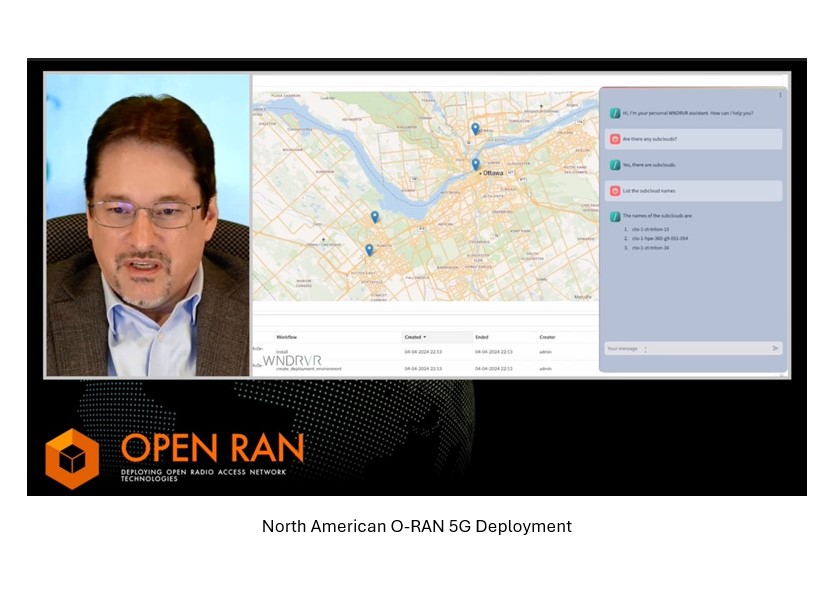
Unveiling the Potential of AI in Telecommunications: The Open RAN Revolution
In the ever-evolving landscape of telecommunications, we find ourselves at a pivotal juncture, propelled by the convergence of Open RAN (Radio Access Networks) and Artificial Intelligence (AI). As Chief Technology Officer at Wind River, I've had the privilege of witnessing firsthand how these transformative technologies are reshaping the fabric of telecom infrastructure.
In a recent interview with TelecomTV, I discussed and demonstrated pivotal role of AI in revolutionizing telecom networks and some specific applications that can improve operations particularly within the context of Open RAN deployments. Let's explore how AI is poised to address the challenges and unlock the opportunities presented by Open RAN.

Navigating the Challenges of Open RAN Deployment
The journey of Open RAN has been marked by significant milestones, with commercial deployments underway across various regions. However, as we transition into this new era, we encounter fresh challenges in managing and operating Open RAN networks at scale.
The sheer magnitude and complexity of these deployments necessitate a shift in network management. Traditional approaches, characterized by manual intervention and siloed operations, are no longer sufficient to ensure the seamless operation of distributed architectures spanning thousands of sites. This is where AI can play a critical role, offering unparalleled capabilities in automation, optimization, and predictive analytics.
Empowering Telecom Networks with AI
AI permeates various facets of telecom operations, offering solutions to critical challenges. For example:
- Dynamic Radio Function Control: AI enables real-time optimization of radio functions within 5G networks, dynamically adjusting signal direction and efficiency based on endpoint locations, network traffic patterns, and environmental conditions. This ensures optimal performance and resource utilization, ultimately enhancing user experience and network efficiency.
- Operational Efficiency: AI-driven automation streamlines network management tasks, ensuring optimal performance and reliability across the Open RAN infrastructure. By automating routine operational tasks such as configuration management, performance monitoring, and fault detection, operators can proactively identify and address issues before they impact service quality. This not only reduces operational costs but also enhances network resilience and agility.
- Predictive Maintenance: AI empowers operators to preemptively identify and mitigate potential network outages through advanced machine learning algorithms. By analyzing historical and real-time data, AI identifies patterns and anomalies indicative of impending failures or performance degradation, enabling proactive maintenance and minimizing downtime.
- Root Cause Analysis: AI's ability to correlate vast amounts of data enables rapid identification of network issues and their root causes. By automating troubleshooting processes, AI-driven analytics streamline the resolution of network issues, improving overall network reliability and performance.
Wind River's AI Integration
At Wind River, we're committed to spearheading the integration of AI into Open RAN deployments. Our solution, Wind River Studio, harnesses the power of AI that goes beyond just training on logs and other KPIs to actually interact with live APIs to ensure real-time access to live systems in order to provide operators with a unified view of their network, predictive analytics, and intuitive natural language interaction. By leveraging AI-driven insights, operators can optimize network performance, reduce operational costs, and enhance customer satisfaction.
Demonstrating AI's Power at Mobile World Congress
At Mobile World Congress, we showcased a compelling demonstration of AI's capabilities in telecom operations. Our AI-powered system, integrated with Wind River's Studio Operator, enabled operators to interact with the network through natural language queries. Through simple conversations, operators could retrieve vital network information, identify potential issues, and even receive recommendations for resolution. This intuitive interface replaces traditional manual approaches, enabling operators to efficiently manage and optimize their networks with ease.
If you would like to see more of Wind River’s AI capabilities, please contact us to schedule a demo.
Charting the Path Forward
Looking ahead, our focus at Wind River is twofold: productization and internal integration. We aim to deliver AI-driven capabilities that empower our customers to navigate the complexities of Open RAN deployments with confidence. Additionally, we're integrating AI tools internally to enhance support capabilities, further strengthening our commitment to driving innovation in telecommunications.
In Conclusion
The convergence of Open RAN and AI heralds a new era of intelligence and efficiency in telecommunications. By embracing these transformative technologies, operators can unlock unprecedented levels of agility, reliability, and performance in their networks. As we embark on this journey, Wind River remains steadfast in our mission to empower operators with the tools and solutions they need to thrive in the digital age.
About the author
Paul Miller is the Chief Technology Officer at Wind River